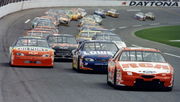
Imago
via Twitter

Imago
via Twitter
“Super Max” or “Mad Max” may be a title for a champion, but even the greatest of champions faces danger at the limits of speed. For Max Verstappen, perhaps no race encapsulates a blend of aggressive driving, championship pressure, and sheer peril like the 2021 Saudi Arabian Grand Prix at the high-speed Jeddah Corniche Circuit. The race, which was packed with incidents, red flags, and virtual safety cars, saw Verstappen involved in several heart-stopping moments, most notably the bizarre Lap 37 collision with Lewis Hamilton. However, there is one thing that might be more dangerous than F1 races.
Watch What’s Trending Now!
The siren song of speed has often led to tragedy, and in the history of NASCAR, the Daytona 500 stands as a somber monument to the sport’s most dangerous days. The most defining and tragic instance of this danger was the fatal final-lap crash of legendary Dale Earnhardt at the 2001 Daytona 500. Earnhardt was blocking opponents in his iconic black No. 3 Chevrolet when he made contact with Sterling Marlin and Ken Schrader, sending his car into the retaining wall. He was pronounced dead shortly after due to a basilar skull fracture. And that is exactly why Verstappen fears oval racing.
ADVERTISEMENT
Why F1’s Champion Max Verstappen draws the line at real-life ovals
Verstappen openly admitted that he enjoys the spectacle of oval racing; however, his admiration for the skill of oval racers is heavily outweighed by a deep-seated concern for the inherent safety risks associated with pack racing and hitting unforgiving walls at extreme velocity. “I like watching all different kinds of racing. For me, it’s just that on Oval, I don’t want to do it just for the risk of injury or when you hit the fence,” he emphasized.
This sentiment reflects the visceral danger of a multi-car pileup, such as the infamous “Big One” at Daytona or Talladega, where drivers can be caught up in violent, inescapable wrecks. Verstappen has made it clear that while he is receptive to other challenges after his illustrious F1 career concludes, the specific discipline of oval racing presents a disproportionate threat to his physical well-being.
The Dutch driver views any potential foray into North American motorsport as a quest for new championships, not merely a novelty or a high-risk adrenaline fix. He suggested that if he were to pursue a career goal outside of F1, it would need to offer substantial sporting reward commensurate with the risk involved. He mused, “It’s not worth it also. If you have done your stuff in Formula 1, maybe you can win more there also. That would be something that I would love.”
ADVERTISEMENT
This indicates his deep-seated competitive nature, where any venture must carry the possibility of adding major titles to his resume, such as the prestigious Daytona 500 or the Indy 500. While F1 is undeniably dangerous, as evidenced by Verstappen’s own 51G crash at the 2021 British Grand Prix, from which he was medically cleared, he contrasted the nature of F1 impacts with those on the oval. In Formula 1, the driver is protected by a carbon fiber monocoque, the Halo device, and vast run-off areas, designed to absorb energy.
Max on Oval racing
“I like watching it. For me its just on Oval. I dont want to do it just for the risk of injury. U know when u hit the fence its not worth it. When u did your stuff in f1 yeah u can win more there and I would probably love that but its not worth the risk of an… pic.twitter.com/MZiFWJc42v
— Laura 🦋 (@formuLau16) November 7, 2025
ADVERTISEMENT
The thought of a high-speed, direct impact into a hard wall remains a terrifying prospect. Verstappen explained the difference in his mind, stating, “It’s not worth the risk of having a really bad accident and hurt yourself really badly. And I know in F1 that can happen as well, but there, beating the wall with 370 or whatever is not something that I’m planning to do.”
Even with NASCAR’s major safety upgrades, like the mandatory HANS device and SAFER barrier after the death of Dale Earnhardt in 2001, the speeds and close proximity make the consequences of an error far more volatile. Ultimately, Verstappen’s stance boiled down to managing risk and avoiding scenarios where the danger is unpredictable and out of his control.
Oval crashes, particularly those in the draft, often result from contact initiated by another competitor, leading to a catastrophic chain reaction. He concluded that the very nature of the racing style increases the likelihood of a major incident, noting that no matter how good a driver is, accidents can happen. “But it’s sometimes not even your fault, right? Anything can happen. Sometimes avoid a little bit of the risk. If you can, I would do that.”
ADVERTISEMENT
For the ultra-calculating champion, that high, uncontrollable risk factor is the insurmountable barrier keeping him off the oval tracks. However, one rising star in NASCAR has seen an ascent almost comparable to Verstappen’s in Formula 1, or maybe even better.
Top Stories
FOX Earns Rare Moment of Respect as NFL Honors NASCAR Legend Live on Air

NASCAR Radio Host Rejects Denny Hamlin’s Warning Amidst Call for Ex-Fox Broadcaster’s Apology

Corey LaJoie Pokes Joey Logano With Backhanded Dig After Star NFL Appearance

Ford Star’s Future in Doubt as 33-Year-Old Rumored to Jump Ship Amid Contract Uncertainty

Racing Broadcaster Gets Emotional as He Warns Fans Against What NASCAR Has Lost

Justin Marks sees a Max Verstappen spark in his young NASCAR star
Trackhouse Racing‘s Justin Marks couldn’t help but draw parallels between his future star, Connor Zilisch, and 4-time F1 World Champion Max Verstappen. He acknowledged, “When you recognise that you’ve got that in a package, you have to run with it. We’ve seen it. I mean, Max to happen and there’s been other drivers that have gotten sort of thrown into the top level at a young age and all of those guys kind of demonstrate the same thing.”
ADVERTISEMENT
Zilisch, who has long admired the world of Formula 1, has even shared that one day he’d like to test his mettle in the open-wheel series. Verstappen, who debuted in F1 at just 17, went on to win his first Grand Prix at 18, setting a record as the youngest-ever winner. Zilisch seems to carry that same early-blooming spark with an impressive 10 victories this season. Yet despite sharing dinner with the Red Bull Champion in Texas, the young Xfinity sensation remains realistic about the massive leap awaiting him in the Cup Series.
Drawing comparisons to Verstappen, Zilisch acknowledged the difference between the two worlds, saying, “Obviously, Max Verstappen is a once-in-a-generation talent, and it’s hard to say, yeah, I’m going to be like him and have as successful as a jump to the highest level as he did, but obviously I know the jump to the Cup Series is nothing easy, and it’s going to be tough no matter what and no matter who you are, and I feel like just the way he was brought up, it might be a little bit easier for him, and especially in F1 with how car-dependent it is, I feel like it’s easier to rise to the occasion.”
By 28, Verstappen has cemented his name among the sport’s elite, having captured 4 straight titles between 2021 and 2024. But as comparisons between the two drivers persist, Zilisch remains cautious not to get lost in the shadow of his hero. Marks made the decisive move to bring the 19-year-old aboard for Trackhouse’s 2026 Cup campaign following Daniel Suarez’s exit. Teaming with Shane van Gisbergen, Zilisch could find in SVG not just a teammate, but also a mentor as he navigates NASCAR’s toughest challenge yet.
ADVERTISEMENT
ADVERTISEMENT
ADVERTISEMENT
ADVERTISEMENT

